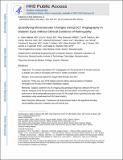Quantifying Microvascular Changes Using OCT Angiography in Diabetic Eyes without Clinical Evidence of Retinopathy
Author(s)
Alibhai, A. Yasin; Moult, Eric Michael; Shahzad, Rida; Rebhun, Carl B.; Moreira-Neto, Carlos; McGowan, Mitchell; Lee, Diane; Lee, ByungKun; Baumal, Caroline R.; Witkin, Andre J.; Reichel, Elias; Duker, Jay S.; Fujimoto, James G; Waheed, Nadia K.; ... Show more Show less
DownloadAccepted version (1.314Mb)
Terms of use
Metadata
Show full item recordAbstract
Objective: To compare quantitative OCT angiography (OCTA) parameters of macular ischemia in diabetic eyes without retinopathy with those in healthy nondiabetic controls. Design: Cross-sectional study from August 2014 through June 2017. Subjects: Thirty-nine eyes of 39 diabetic patients without clinical evidence of diabetic retinopathy and 40 eyes of 40 healthy nondiabetic subjects. Methods: Subjects underwent OCTA imaging using prototype AngioVue software (RTVue XR Avanti). Analyses of the foveal avascular zone (FAZ) and vasculature surrounding the FAZ were performed on the automatically generated en face OCTA images of the superficial and deep retinal vasculatures using vessel-based and FAZ-based metrics. Main Outcome Measures: Comparison of measurements made in the superficial and deep retinal capillary plexuses of diabetic eyes and normal eyes. Results: FAZ-based analysis revealed statistically significant differences between diabetic and normal eyes in FAZ area (superficial and deep layers), perimeter (superficial layer), major axis length (superficial layer), and minor axis layer (superficial and deep layers). Vessel-based analysis revealed statistically significant differences in the binarized flow index (superficial and deep layers), both including and excluding the FAZ area. Conclusions: Quantitative OCTA parameters reveal subclinical macular ischemia at both the superficial and deep retinal capillary plexuses in diabetic eyes that do not manifest clinical retinopathy. Vessel-based and FAZ-based metrics applied to OCTA images may serve as effective tools for screening and disease monitoring in patients with diabetes without clinical evidence of retinopathy.
Date issued
2018-05Department
Massachusetts Institute of Technology. Department of Electrical Engineering and Computer Science; Massachusetts Institute of Technology. Research Laboratory of ElectronicsJournal
Ophthalmology Retina
Publisher
Elsevier BV
Citation
Alibhai, A. Yasin et al. "Quantifying Microvascular Changes Using OCT Angiography in Diabetic Eyes without Clinical Evidence of Retinopathy." Ophthalmology Retina 2, 5 (May 2018): 418-427 © 2017 by the American Academy of Ophthalmology
Version: Author's final manuscript
ISSN
2468-6530